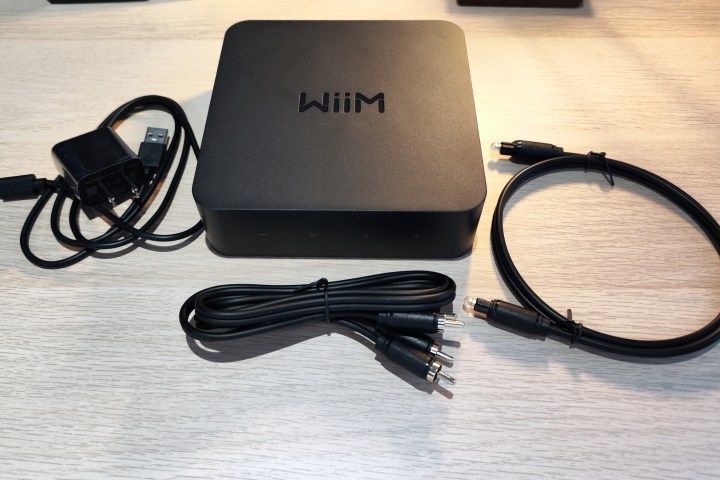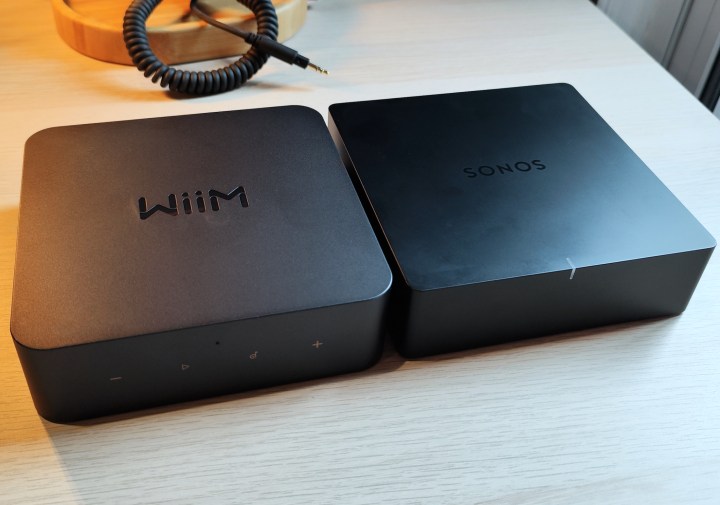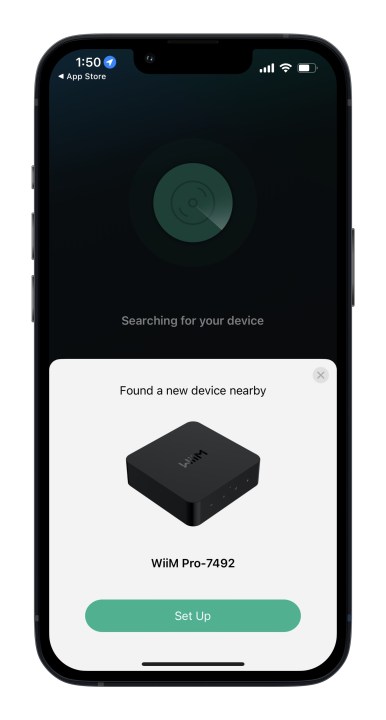- Highly affordable
- 24-bit/192kHz lossless audio
- Excellent app design
- AirPlay/Chromecast/Bluetooth
- Strong streaming service support
- Lots of connections
- No Apple Music/YouTube Music access in the app
No company has done more to make wireless audio ubiquitous than Sonos. Its collection of wireless speakers — which just received a major update with the Era 100 and Era 300 — has earned praise from critics and customers alike, not just for how they sound, but also for how they look. But I’d argue that what really makes Sonos, well, Sonos, is its software. The Sonos app and the code that runs on its products have served as the gold standard for home audio because they’re easy to use — and they work with just about every music source you can name, from people’s personal iTunes music collections to the most obscure streaming service. As the saying goes, it’s been often imitated but never equaled. Until now.
Wiim — a relatively new brand from a company called LinkPlay — has just launched its second product, the $149 Wiim Pro. It’s a direct competitor to the $449 Sonos Port. Both devices are designed to give your existing, non-wireless audio system a smart upgrade, so you can still enjoy the sound system you love while giving it access to the full range of features and streaming sources that a wireless speaker offers.
The Wiim Pro isn’t just similar to the Sonos Port — it’s practically a carbon copy.
While plenty of companies have copied Sonos, like Denon, Bose, and Bluesound, none have managed to do so at a significantly lower price or been able to develop a truly competitive app-based experience. The Wiim Pro does both. And if it’s a sign of LinkPlay’s ultimate ambitions in the whole-home wireless audio space, Sonos has every reason to be worried.
A little black box
- 1. Wiim Pro with accessories
- 2. Wiim Pro (left) and Sonos Port
Physically, the Wiim Pro isn’t just similar to the Sonos Port — it’s practically a carbon copy, right down to the fact that both “WIIM” and “SONOS” are ambigrams (they look the same right-side up, or upside down). They’re both made from black plastic, their dimensions are within a millimeter or two of each other, and even their circle-in-a-square bottom panels bear a strong resemblance to one another. Both devices come with a power adapter and a set of RCA cables for analog connections, but the Wiim goes a step further with an included optical cable.
To be fair, the Port feels more substantial in your hand, and it uses higher-quality plastic than the Wiim Pro. But these aren’t smartphones. Once you plug it into your sound system, there’s almost no reason to touch it again.
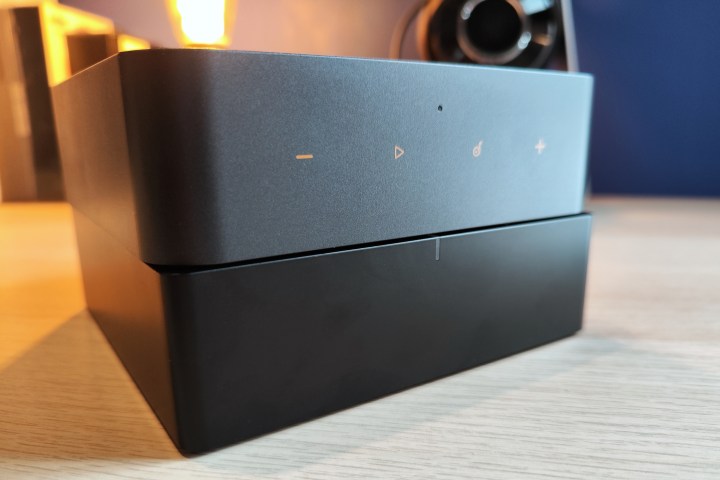
That leads us to the differences. Both devices have indicator lights on the front for power, but the Wiim Pro also features touch controls for volume (which can be swapped for track skipping), playback, and presets. I’m sure that Sonos figures most folks will prefer using the app for these functions, but it’s still a bit ironic that the company offers excellent touch controls on its other products, but not on the Port.
The Wiim Pro is festooned with wireless options.
A glance at the back panel reveals more similarities (and differences), with the biggest being the Wiim Pro’s digital port selection. You get an optical input, plus an optical and coaxial digital set of outputs. The Port only has a single coaxial digital output — a curious choice given that optical inputs tend to be more common on a variety of speakers, TVs, and AV receivers.
Sonos has been somewhat resistant to providing inputs on its products — especially digital ones. Only its soundbars offer this option, so this gives the Wiim Pro another advantage.
All of the wireless connections
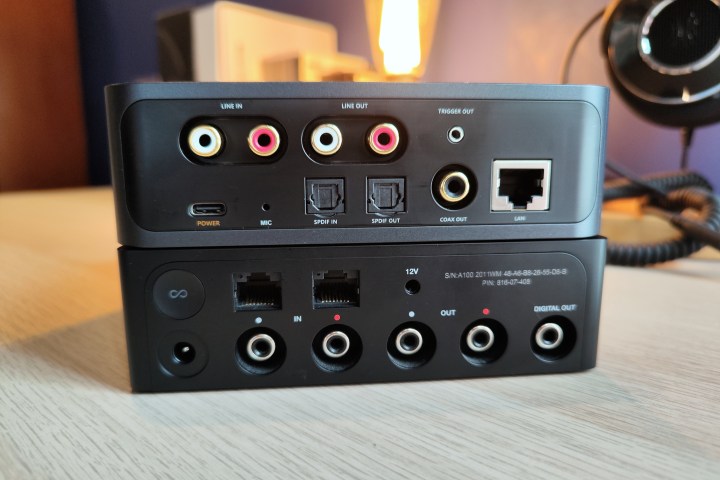
Since the Sonos One, Sonos has been including Apple’s AirPlay on all of its products, including the Port. This gives Apple device owners a way to play music on a Sonos device without using the Sonos app. There’s also support for Spotify Connect and Tidal Connect, which lets you control your Sonos products directly from within these third-party apps. Only the company’s two portable speakers (the Move and the Roam) and its newest wired models (the Era 100 and 300) include Bluetooth.
The Wiim Pro, by contrast, is festooned with wireless options. You can use the Wiim app to access a variety of streaming services, or AirPlay, Bluetooth, and Chromecast Audio — the latter two options will be especially useful to Android users — as well as Spotify Connect/Tidal Connect.
The Wiim Pro doesn’t quite tick all of the audiophile boxes, but it comes very close.
Sonos has been criticized for not offering any kind of headphone listening experience, which makes the Wiim Pro all the more impressive. It supports Bluetooth as an output — a feature that’s very rare in the wireless multiroom universe — letting you pipe music from the Wiim Pro to a set of wireless headphones, earbuds, or literally any Bluetooth speaker you may own.
All of the formats

Sonos supports a wide variety of both lossy and lossless formats, but it has a hard limit on resolution that die-hard audiophiles may find annoying: audio quality can’t exceed 24-bit/48kHz. If a music stream service has a matching version of a track — that’s what you’ll get. But if your chosen service only maintains higher quality versions e.g. 24-bit/96kHz, and doesn’t have the ability to adapt that to a 24/48 version (which is sometimes the case with Qobuz), it must send Sonos the best version that Sonos can play — typically 16-bit/44.1kHz.
Sonos’ reign as the undisputed king of the wireless audio experience has met its first genuine challenger.
This is unfortunate given that the Port is specifically designed to deliver analog and digital audio to a third-party sound system. If you’ve taken pains to make that system the best that it can be, it feels odd that the Port can’t match your enthusiasm all the way up to the highest possible level.
The Wiim Pro doesn’t quite tick all of the audiophile boxes (it doesn’t decode DSD), but it comes very close, with support for hi-res lossless ALAC, APE, FLAC, and WAV, up to 24-bit/192kHz, in addition to the usual lossy suspects, MP3, AAC, WMA, and OGG. There’s even beta-level support for the MQA format, which Tidal uses to deliver its top-tier Masters tracks, something that Sonos does not support.
A killer app
As I mentioned in the intro, building capable hardware is one thing — and there are several excellent alternatives to the Sonos Port from a hardware point of view. But making that hardware a cinch to set up and a joy to use? That’s a lot harder to do, and no one does it as well as Sonos. But its reign as the undisputed king of the wireless audio experience has met its first genuine challenger: the Wiim app is the closest match to Sonos I’ve ever seen.
It begins with an effortless, 2-minute-or-less setup procedure that includes a clever audio latency measurement. Using a built-in mic, the Wiim Pro evaluates the lag between when it sends audio to your system and when your system produces sound. This is unnecessary for a single room or speaker, but if you want to expand your Wiim system, it’s critical to get perfectly synchronized sound between all speakers.
You can then (optionally) enable Chromecast Audio (which also enables Google Assistant voice control) and Amazon Alexa access, and there’s also a shortcut to the Apple Home app (iOS only) so you can add the Wiim Pro to Apple’s smart home system.
Once you’re up and running, the app interface will be immediately familiar to Sonos users, and it’s simple to navigate even if you’ve never used a wireless music system before.
Four tabs along the bottom organize the app’s main functions — browse, device, search, and settings — though on a day-to-day basis, you’ll probably stick to the first three.
Browse is an all-in-one list of all the music sources the Wiim app supports. The My Library section is devoted to your personal music (on your phone and on your network), while the Music Services section shows you which streaming services are available. It’s an impressive list with lots of choices, but you’ll notice two very conspicuous omissions: Apple Music and YouTube Music.
It would be nice if these services were included — the way they are on Sonos — but thanks to the Wiim Pro’s superb wireless options, you can still play music from these services directly from within their respective apps, using Bluetooth, AirPlay, or Chromecast Audio.
You can sign into any service that’s listed in the Music Services list, and once you do, you’ll be able to browse them directly from the same list. If you see services that you don’t subscribe to or simply aren’t interested in, you can hide them from the list using the Manage feature.
The Device tab is where you’ll find all of your LinkPlay-compatible players like the Wiim Pro. Each device is listed according to the room name you gave them during the setup, and an easy-to-read card for each room shows what’s currently playing, along with a volume control, a speaker grouping function, and access to the player’s settings.
Speaker (or streamer) grouping works much like it does on Sonos. Bring up the devices tab and select the chain icon on the card belonging to the device you want to use as the primary in the group. A pop-up will then let you add as many other Wiim devices on your network as you like, to the group. I tried it with a Wiim Pro and a Wiim Mini, and synchronization between the two sounded bang on to me.
Cleverly, once grouped, the Wiim app lets you decide if you want each device to play the full stereo stream, or if each device should play just one channel. Sonos only lets you create these kinds of stereo pairs if both devices are identical e.g. two Era 100s or two Era 300s.
Universal search
It’s the app’s third tab that I want to call your attention to. Unless you’ve tried Sonos’ competitors — and noted the feature’s absence — you may not realize how powerful a true universal search can be. The key to getting the most out of your digital music, whether it’s your private library of albums and playlists or your subscription to a streaming music service, is being able to find what you’re looking for.
Without a universal search, you have to more or less know where to look for your music before you start searching. You must then tediously go about the task of searching again and again within each source. With universal search, you just ask for anything, and the results are grouped by source. And if you want to restrict a search to just one of your sources, there’s a secondary search option in the top-right corner to do just that.
Of all the Sonos features the Wiim Pro provides, this one is my favorite.
A tiny gap
On some streaming services, like Amazon Music, there’s no way to designate favorite tracks, albums, playlists, or artists. In this scenario, you can’t build your own Wiim-based playlists from the content either. Wiim says this is a limitation with the current implementation of the Amazon Music service and that it should be fixed with a future update.
It’s not a total deal breaker, because you can still access any favorites or playlists you have created within your subscription services. For example, when browsing Amazon Music, you can see your My Music favorites.
Settings galore
At a basic level, the Wiim Pro is ready to play your music the moment you finish the setup. But in keeping with the device’s audiophile orientation, if you want to take a deeper dive and get into the weeds, the app lets you access a wide variety of settings.
You can decide which of the three outputs to use (analog, coax, or optical), choose the input, set music alarms, choose to set your own EQ using a 10-band equalizer, or pick from a huge list of EQ presets. There’s even the ability to select the sampling bit-depth and frequency for the digital outputs, in case your audio gear might be on the older side and works better with lower values.
There’s also good news for fans of the Roon music control system: the Wiim Pro is undergoing Roon certification and is expected to be fully compliant before the end of June 2023.
This is just the beginning
As an affordable, feature-filled wireless audio adapter, the Wiim Pro is incredibly easy to recommend. But its superb app-driven interface means that the Wiim Pro doesn’t just look like a Sonos Port, but it pretty much works like one too — and that’s saying a lot.
Sonos began its wireless music journey in 2004 with the amplified ZonePlayer, which still lives on today as the Sonos Amp. It followed that with the non-amplified ZP80 (today’s Sonos Port).
Presumably, LinkPlay is embarking on the same journey with the Wiim Pro and its more affordable sibling, the Wiim Mini. I think we can expect to see the company debut wireless speakers next, and if their quality and price are reflective of what I’ve seen in the Wiim Pro, I predict more than a few sleepless nights for the team at Sonos.
Editor’s note: updated with information on grouped device playback.


